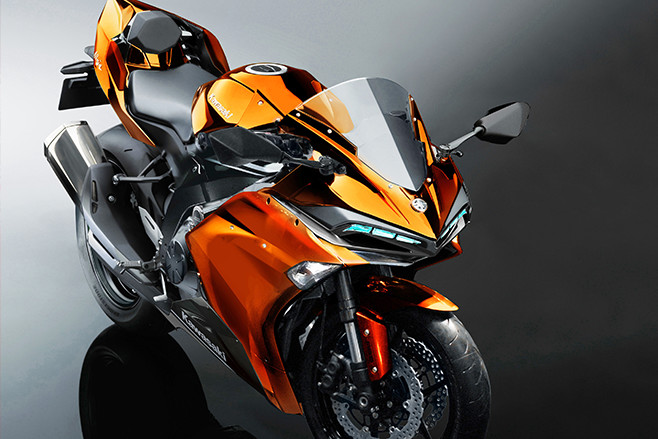This image might be a computer-generated impression but it’s based on information from Japan about the direction Kawasaki will head with its supercharged technology. Miniaturised and more mass-made than the H2, the bike – likely to be called the Ninja R2 – is said to be around 800cc and will use a version of the balanced supercharged engine that the firm displayed at last year’s Tokyo Motor Show.
The capacity comes as a surprise. Last year Kawasaki spoke of the scalable nature of its supercharged engine design, leading to speculation a 600cc machine would be next. Now sources say the scaled-down engine will have a capacity fractionally over 800cc and, when you think about it, makes a lot of sense.
An 800cc four-cylinder engine won’t physically be much larger than a 600cc and given the new Kawasaki will be a road-only bike, and as such won’t be constrained by racing class requirements, there’s no need to hamstring itself by downsizing to 600cc. Instead the firm is able to look at what might be considered ‘ideal’ power and torque characteristics for what will still be a top-of-the-range superbike, balanced against size, cost and weight, and come up with a compromise that’s as close to perfection as it can achieve.

At around 800cc, it won’t be compared to 600cc bikes, its power will rival 1000cc superbikes, as will its cost and, given the current weak market for smaller sportsbikes it makes sense to steer clear of them. While it would be easy to make a supercharged 600 that rivalled naturally-aspirated 1000, the engine would need to be in a higher state of tune, adding to the cost of components and leading to a tighter power band, with little or no real advantage over using a larger engine.
Oomph
The R2 can be lighter, cheaper and still have more than enough power and torque for the real world. How much? Forced induction means it’s hard to guess, as more boost can easily lead to huge increases. Using the H2 as a yardstick, we can probably expect around 135kW (180hp) and 108Nm of torque. Those figures put it into the same ballpark as the average 1000cc superbike, but rather than being tuned for out-and-out power, it’s designed to offer the broadest possible spread of performance.
How
The stand-out technology is the variable-angle vanes on the supercharger intake, altering both the amount of air that can get in and the way that it moves. Kawasaki has spent years developing its own in-house supercharger technology, and the exact way this system will affect performance has yet to be seen, but it’s believed to widen the useable rev range of the engine, boosting performance at both low and high revs, as well as improving economy.
Looks
Given the bike’s mass-made intentions, our Japanese sources reckon it will use a beam frame instead of the handmade tubular chassis of the H2, and it won’t be as wildly styled as the first-generation supercharged machine. The nose design used here is influenced by leaked pictures of Kawasaki’s next-generation Ninja 300, which is going to use similar headlights.
Name
The Ninja R2 name has already been trademarked by Kawasaki in Japan, along with ‘R2-R’ – which hints that there may also be a track-only, higher performance derivative. The firm has also registered the names ‘Ninja S2’ and ‘Ninja S2-R’ which could potentially be used on a naked or half-faired variant. ‘Ninja E2’ is yet another title that the company owns, but it’s believed to be reserved for the electric sportsbike project.
Next
Kawasaki has said it has 12 new models due for release in the next two years and more than one of them will be supercharged. We’ve already seen two sketches. The SC-01 Spirit Charger, the half-faired retro bike heavily based on the existing H2 that’s likely to be a low-volume, high-priced machine. The second, the SC-02 Soul Charger, is smaller, naked and less exotic than the H2 or SC-01 and it’s conceivable that it could use the R2’s engine.











